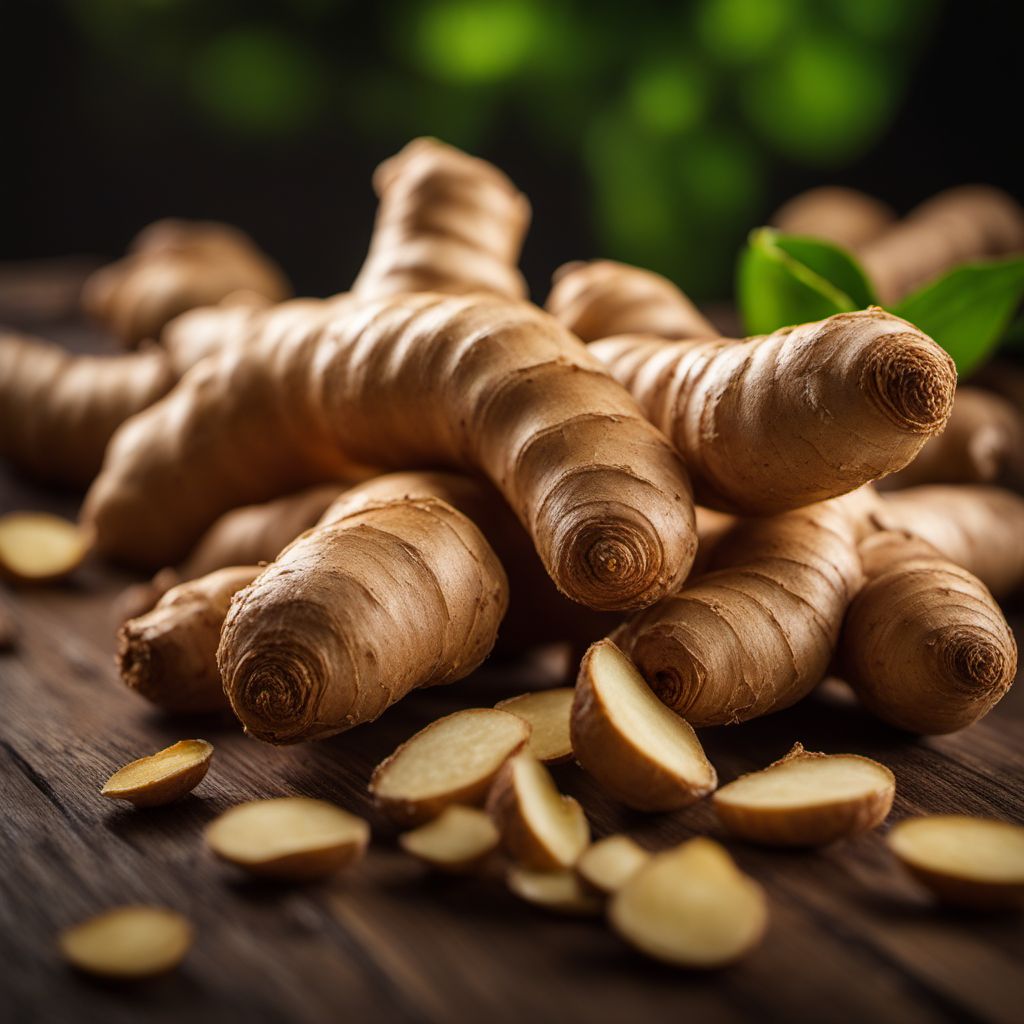
Ingredient
Ginger roots and similar-
The Zesty Root: Ginger and Its Kin
Ginger roots have a knobby appearance with a pale yellow interior and a thin, tan skin that can be easily peeled. They have a pungent, spicy, and slightly sweet taste, while galangal offers a more citrusy and earthy flavor, and turmeric adds a warm, bitter, and peppery note to dishes. These roots are commonly used fresh, dried, or ground into a powder.
Origins and history
Ginger has a long history of cultivation and use in various cultures, including ancient China and India. It was highly valued for its medicinal properties and was traded along the Silk Road, contributing to its spread across different regions. Galangal and turmeric are also widely used in Asian cuisines, particularly in Thai, Indonesian, and Indian dishes.
Nutritional information
Ginger roots and similar rhizomes are low in calories and fat, while being rich in vitamins (such as vitamin C and B vitamins), minerals (such as potassium and manganese), and antioxidants (such as gingerol and curcumin). They also possess anti-inflammatory and digestive properties.
Allergens
Ginger roots and similar rhizomes may cause allergic reactions in some individuals, particularly those with sensitivities to spices or related plants. It is advisable to exercise caution and consult a healthcare professional if you have any concerns.
How to select
When selecting ginger roots and similar rhizomes, choose ones that are firm, plump, and free from mold or signs of decay. Look for smooth skin and a fresh aroma. Galangal should have a firm texture and a strong fragrance, while turmeric should be vibrant in color and free from blemishes.
Storage recommendations
To keep ginger roots fresh, store them in a cool, dry place, such as the refrigerator. They can be wrapped in a paper towel or placed in a breathable bag to prevent moisture buildup. Galangal and turmeric should be stored in a similar manner. Dried ginger, galangal, and turmeric should be kept in airtight containers away from heat and light.
How to produce
Ginger roots can be grown at home by planting fresh ginger rhizomes in well-drained soil and providing them with warmth, moisture, and indirect sunlight. Galangal and turmeric can also be cultivated in a similar manner, although they may require specific growing conditions depending on the variety.
Preparation tips
Ginger roots and similar rhizomes can be used in a variety of culinary preparations. They can be grated, sliced, or minced and added to stir-fries, soups, curries, marinades, and baked goods. They can also be infused into teas, syrups, or cocktails for a refreshing and aromatic twist. Galangal and turmeric are commonly used in Thai and Indonesian dishes, adding depth of flavor and vibrant color to curries, soups, and sauces.
Culinary uses
Ginger roots and similar rhizomes are widely used in Asian cuisines, particularly in dishes from China, India, Thailand, Indonesia, and Malaysia. They are also popular in Western cuisines, where they are incorporated into gingerbread, ginger ale, and various desserts. Galangal and turmeric are essential ingredients in Thai curries and Indonesian dishes, such as rendang and sambal.
Availability
Ginger roots are cultivated in many countries, including China, India, Nigeria, and Thailand. Galangal is primarily grown in Southeast Asia, particularly in Indonesia and Thailand. Turmeric is cultivated in India, China, Indonesia, and other tropical regions.
More ingredients from this category

Lesser galangal roots
The Aromatic Spice

Fingerrot roots
The Exotic Spice

Orris root
The Fragrant Rhizome of Elegance

Greater galangal roots
The Aromatic Spice: Unveiling the Secrets of Greater Galangal Roots

East Indian galangal
The Exotic Spice of East India

Ginger roots
The Zesty Wonder: Unleashing the Power of Ginger Roots

Wasabi roots
The Fiery Green Elixir: Unveiling the Secrets of Wasabi Roots

Galangal roots
The Exotic Spice: Galangal Roots